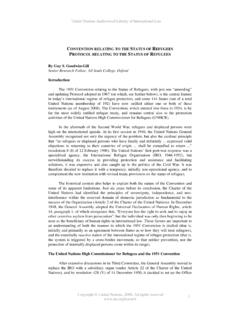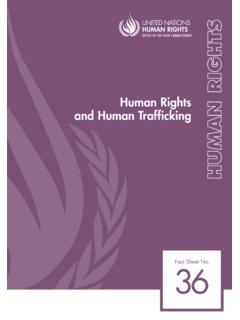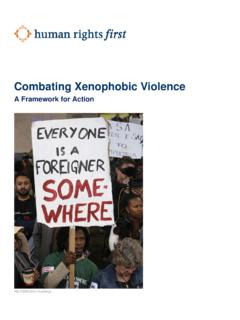Transcription of refugees - unhcr.org
1 Convention and p ro t o c o l r e l at i n g t o t h e s tat u s o f P ublished by : refugees UNHCR. Communications and Public Information Service Box 2500. 1211 Geneva 2. Switzerland For information and inquiries, please contact: Communications and Public Information Service Text of the 1951 Convention Relating to the Status of refugees Text of the 1967 Protocol Relating to the Status of refugees Resolution 2198 ( XXI ) adopted by the united nations General Assembly with an Introductory Note by the Office of the united nations High Commissioner for refugees convention and protocol 1. introductory note by the Office of the united nations High Commissioner for refugees ( UNHCR ). Grounded in Article 14 of the Universal Declaration of human rights 1948, which recognizes the right of persons to seek asylum from persecution in other countries, the united nations Convention relating to the Status of refugees , adopted in 1951, is the centrepiece of international refugee protec- tion today.
2 (1) The Convention entered into force on 22 April 1954, and it has been subject to only one amendment in the form of a 1967 Protocol, which removed the geographic and temporal limits of the 1951 Convention. (2) The 1951 Convention, as a post-Second World War instrument, was originally limited in scope to persons fleeing events occurring before 1 January 1951 and within Europe. The 1967 Protocol removed these limitations and thus gave the Convention universal coverage. It has since been supplemented by refu- gee and subsidiary protection regimes in several regions,(3) as well as via the progressive development of international human rights law. (1) united nations General Assembly resolution 429(V) of 14 December 1950, available at (2) The Convention enabled States to make a declaration when becoming party, according to which the words events occurring before 1 January 1951 are understood to mean events occurring in Europe prior to that date. This geographical limitation has been maintained by a very limited number of States, and with the adoption of the 1967.
3 Protocol, has lost much of its significance. The Protocol of 1967 is attached to united nations General Assembly resolution 2198 (XXI) of 16 December 1967, available at (3) See, for example, the Organization of African Unity (now African Union) Convention governing the Specific Aspects of Refugee Problems in Africa 1969, adopted in Addis Adaba, 10 September 1969; the European Union Council Directive 2004/83/EC of 29 April 2004 on minimum standards for the qualification and status of third country nationals or stateless persons as refugees or as persons who otherwise need international protection and the content of the protection granted, Official Journal L 304 , 30/09/2004 P. 0012 0023. The Cartagena Declaration on refugees , adopted at a colloquium held at Cartagena, Colombia, 19-22 November 1984, while non-binding, also sets out regional standards for refugees in Central America, Mexico and Panama. 2 convention and protocol The 1951 Convention consolidates previous international instruments relat- ing to refugees and provides the most comprehensive codification of the rights of refugees at the international level.
4 In contrast to earlier internation- al refugee instruments, which applied to specific groups of refugees , the 1951. Convention endorses a single definition of the term refugee in Article 1. The emphasis of this definition is on the protection of persons from politi- cal or other forms of persecution. A refugee, according to the Convention, is someone who is unable or unwilling to return to their country of origin owing to a well-founded fear of being persecuted for reasons of race, religion, nationality, membership of a particular social group, or political opinion. The Convention is both a status and rights-based instrument and is under- pinned by a number of fundamental principles, most notably non-discrim- ination, non-penalization and non-refoulement. Convention provisions, for example, are to be applied without discrimination as to race, religion or coun- try of origin. Developments in international human rights law also reinforce the principle that the Convention be applied without discrimination as to sex, age, disability, sexuality, or other prohibited grounds of discrimination.
5 The Convention further stipulates that, subject to specific exceptions, refu- gees should not be penalized for their illegal entry or stay. This recognizes that the seeking of asylum can require refugees to breach immigration rules. Prohibited penalties might include being charged with immigration or crim- inal offences relating to the seeking of asylum, or being arbitrarily detained purely on the basis of seeking asylum. Importantly, the Convention contains various safeguards against the expulsion of refugees . The principle of non- refoulement is so fundamental that no reservations or derogations may be made to it. It provides that no one shall expel or return ( refouler ) a refugee against his or her will, in any manner whatsoever, to a territory where he or she fears threats to life or freedom. Finally, the Convention lays down basic minimum standards for the treat- ment of refugees , without prejudice to States granting more favourable treat- ment. Such rights include access to the courts, to primary education, to work, and the provision for documentation, including a refugee travel document in passport form.
6 Most States parties to the Convention issue this document, which has become as widely accepted as the former Nansen passport , an identity document for refugees devised by the first Commissioner for Refu- gees, Fridtjof Nansen, in 1922. convention and protocol 3. The Convention does not however apply to all persons who might otherwise satisfy the definition of a refugee in Article 1. In particular, the Convention does not apply to those for whom there are serious reasons for considering that they have committed war crimes or crimes against humanity, serious non-political crimes, or are guilty of acts contrary to the purposes and prin- ciples of the united nations . The Convention also does not apply to those refugees who benefit from the protection or assistance of a united nations agency other than UNHCR, such as refugees from Palestine who fall under the auspices of the united nations Relief and Works Agency for Palestine refugees in the Near East (UNRWA). Nor does the Convention apply to those refugees who have a status equivalent to nationals in their country of asylum.
7 Apart from expanding the definition of a refugee, the Protocol obliges States to comply with the substantive provisions of the 1951 Convention to all per- sons covered by the refugee definition in Article 1, without any limitation of date. Although related to the Convention in this way, the Protocol is an independent instrument, accession to which is not limited to States parties to the Convention. Under the Convention and Protocol, there is a particular role for UNHCR. States undertake to cooperate with UNHCR in the exercise of its functions, which are set out in its Statute of 1950 along with a range of other General Assembly resolutions, and, in particular, to facilitate this specific duty of supervising the application of these instruments. By its Statute, UNHCR is tasked with, among others, promoting international instruments for the pro- tection of refugees , and supervising their application. The fundamental importance and enduring relevance of the Convention and the Protocol is widely recognized.
8 In 2001, States parties issued a Declaration reaffirming their commitment to the 1951 Convention and the 1967 Protocol, and they recognized in particular that the core principle of non-refoulement is embedded in customary international law.(4) Moroever, the General Assem- bly has frequently called upon States to become parties to these instruments. (4) Declaration of States parties to the 1951 Convention and/or its 1967 Protocol Relating to the Status of refugees , Ministerial Meeting of States Parties, Geneva, Switzerland, 12-13 December 2001, UN Doc. HCR/MMSP/2001/09, 16 January 2002. The Declaration was welcomed by the UN General Assembly in resolution A/RES/57/187, para. 4, adopted on 18 December 2001. 4 convention and protocol Accession has also been recommended by various regional organizations, such as the Council of Europe, the African Union, and the Organization of American States. As UNHCR prepares to commemorate, in 2011, the 60th anniversary of the 1951 Convention, it is hoped that more States will accede to these instruments.
9 Today, there are 147 States Parties to one or both of these instruments. In view of the increasing recognition of the fundamental significance of the Convention and the Protocol for the protection of refugees and for the estab- lishment of minimum standards for their treatment, it is important that their provisions be known as widely as possible, both by refugees and by all those concerned with refugee problems. Additional information on the Convention and the Protocol, including acces- sion details, may be obtained from UNHCR, or directly from the UNHCR. website at Geneva, December 2010. convention and protocol 5. final act of the united nations Conference of Plenipotentiaries on the Status of refugees and Stateless Persons I. The General Assembly of the united nations , by Resolution 429 (V) of 14. December 1950, decided to convene in Geneva a Conference of Plenipoten- tiaries to complete the drafting of, and to sign, a Convention relating to the Status of refugees and a Protocol relating to the Status of Stateless Persons.
10 The Conference met at the European Office of the united nations in Geneva from 2 to 25 July 1951. The Governments of the following twenty-six States were represented by delegates who all submitted satisfactory credentials or other communica- tions of appointment authorizing them to participate in the Conference: Australia Italy Austria Luxembourg Belgium Monaco Brazil Netherlands Canada Norway Colombia Sweden Denmark Switzerland (the Swiss delegation also Egypt represented Liechtenstein). France Turkey Germany, Federal Republic of united Kingdom of Great Britain Greece and Northern Ireland Holy See united States of America Iraq Venezuela Israel Yugoslavia The Governments of the following two States were represented by observers: Cuba Iran Pursuant to the request of the General Assembly, the united nations High Commissioner for refugees participated, without the right to vote, in the deliberations of the Conference. 6 convention and protocol The International Labour Organisation and the International Refugee Organization were represented at the Conference without the right to vote.

















